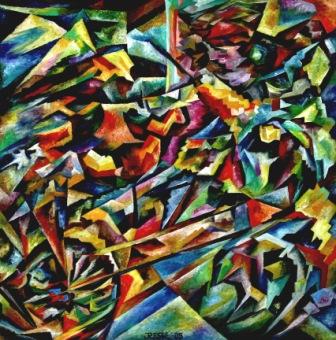Rayonizm – direction of abstract art.
Also based on the idea of the emergence of spaces and forms of “crossing the reflected rays of various objects.” Man really is not seen the object itself, and “the amount of rays from the light source reflected from the object and got in our field of vision.” The beams are transmitted on a cloth with color lines. In Beams worked Michael Le Dante and other artists “Donkey’s Tail”. A special development was in the works Rayonism SM Romanovich, who coloristic ideas Rayonism made the basis of “spaciousness” of the paint layer of figurative painting.
Founder flow Mikhail Larionov believed that the beam should be conditionally depicts a colored line on the plane. Beams rank as one of the early versions of abstract painting, but he has other, broader issues such as the separation of the object from its optical perception. That is why an artist should not portray the subject, but only the rays falling on it. But as our eyes are rays falling not only on the subject, but on the next items, then why an artist should “mentally” to comprehend, imagine and represent, respectively, so to speak, a radiant kind of thing. “It’s almost the same thing – says Larionov – that mirage, appearing in the hot air of the desert painting in the sky distant cities, lakes, oases – Rayonism erases the boundaries that exist between the image plane and in kind.” The “radiant” picture of the real world objects have no value except as Larionov calls “realistic Rayonism” where the object is a point of departure. Ray conditionally depict colored line and thus, according to Larionov, can best be identified being of painting itself – “a combination of color, its intensity, the ratio of the masses of color, in-depth, texture on all this …”.
Beams was one of the first examples of abstract painting. Turner exhibition, which Larionov saw in London in 1906, led him to reflect on the color in the painting and the artist begins to take shape as the light rays, whence came the term “Rayonism.” Beams Larionov made a noise in his time as one of the many sensational events, then-fashionable art. Those were the years when in Russia and especially in Moscow, according to Sergei Diaghilev, “twenty schools were born in the month: Futurism, Cubism – it is antiquity, prehistory … The exhibition is organized in the palaces and in the attic …”.
In 1909, the Moscow Society of Free Aesthetics Larionov showed his first painting in a new style – “Glass” (New York, Solomon R. Guggenheim Museum); the painting was exhibited only one day and the next time is shown only after three years at the “Donkey’s Tail”, together with other luchistskimi works. In 1910 he was joined by Natalia Goncharova and brothers David and Vladimir Burliuk. They formed a group of “Jack of Diamonds”. At exhibitions association participated Gleize, Lefokone, Kandinsky.
In 1911, Larionov left the “Jack of Diamonds” and preparing “Rayonism Manifesto”, which was signed by 11 artists. Published only in 1913, this manifesto reveals Larionov principles: the purpose of art – to convey the fourth dimension. Therefore, the picture itself should be out of time and space. It should consist of the light rays, not only because the color is the driving “law”, but also because of its tone and strength give new forms of meaning. Although long overdue publication of the manifesto (and coincided with the “Black Square” by Malevich), the use of “rays” of pure color is one of the earliest examples of figurative painting is not.
In 1914, Larionov arranges exhibition in Paris, the preface to the catalog which was written by Apollinaire. After that, Larionov and his wife creates sketches and scenery for a group of Russian ballet of Diaghilev and almost ceases to paint.
